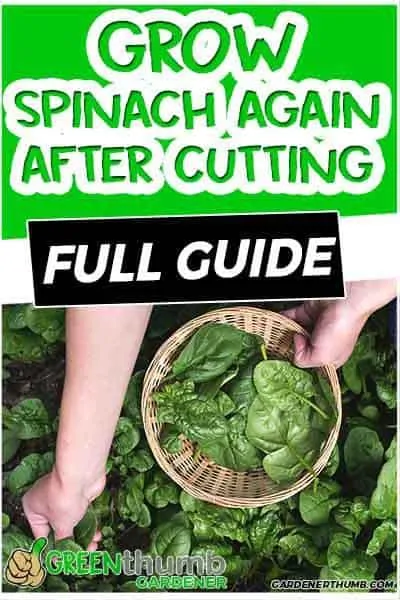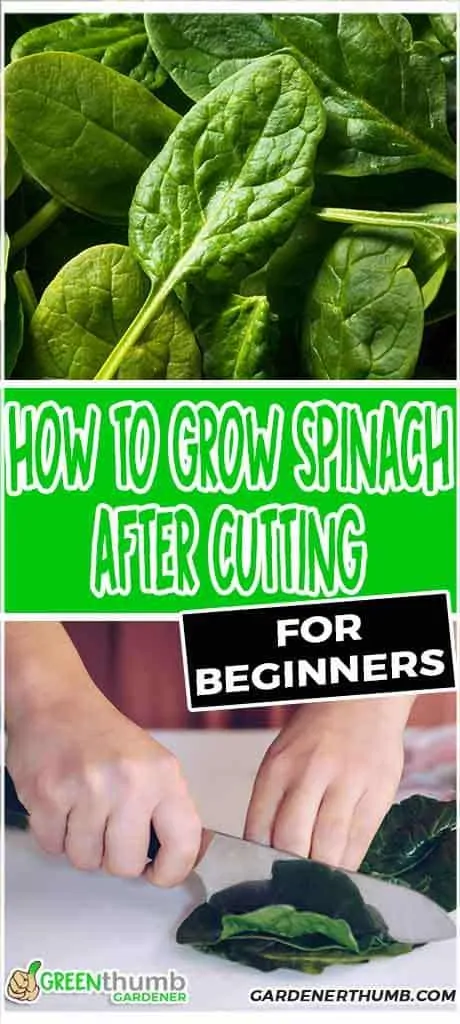Will Spinach Grow Back After Cutting?
Last updated: 9/11/2020
Will spinach grow back after cutting?
With the increase in gardening these days, many may have this question.
The most important thing you should do is plant veggie crops you can regrow to help support yourself and family.
Some are talking about growing cut-and-come-again gardens.
This may just be the best and most practical solution for everyone.
Green thumb Gardener occasionally links to product and/or services offered by vendors to assist you with all your gardening needs. Some of these may be affiliate links, meaning we earn a small commission if items are purchased.
Want to Download a Garden Hack Guide for FREE

Enter your email below and we will send you a guide to help you SAVE money in your garden.
Does Spinach Regrow After Cutting It?
The all-important growing point…
The answer is, yes!
Spinach has the ability to regrow its leaves, provided that the growing point on your plant is left undamaged.
When the growing point of your spinach plant is left intact, especially during the first harvesting of the leaves, you’re doing the right thing.
One special feature of the spinach plant is its ability to regenerate leaves from where they grew the first time.
Where exactly?
The growing point is located at the crown of your plant, where the plant’s stem connects with the root system, above the surface of the soil.
In order to allow your plant to regrow its leaves, you should take special care when you are harvesting leaves for the first time.
If you accidentally cut and damage the growing point in any way, your plant will fail to regrow and, thus, be unable to provide you with more spinach leaves.
If you take care not to damage the growing point, the leaves should almost immediately start to regrow for the next harvest within four weeks.
Of course, if the plant goes into seed, the regrowth of the leaves will stop growing.
However, if it doesn’t start to produce seeds, it can produce a couple or several more cycles of regrowth.
Best Way To Harvest Spinach
The following is a guide on the best method for harvesting your spinach cut-and-come-again vegetable plant.
The whole purpose for popularizing this harvesting method for “cut and come again veggies,” especially spinach, is to allow your plant time to rejuvenate their leaves for the next harvest.
Your plant is capable of performing this feat if you refrain from damaging the growing point, as mentioned earlier, especially during the first harvest as the plant continues to grow.
The weather should be cool and frost-free, and planting is done in Spring or Fall.

In milder climates, it is also acceptable from Spring through Fall.
The Difference Lies In The Harvesting Method
This is where the basic difference can be seen between cut-and-come-again vegetables, as well as many other vegetables.
The former veggies are harvested differently from traditional harvesting methods used by gardeners.
You will recognize the cut-and-come-again vegetables from the special structure of their leaves.
Unlike many other vegetables, these produce a rosette formation in their leaves.
This simply means the spinach plant produces its leaves in a circular form.
To further illustrate, newly formed leaves protrude from the center. While the older leaves are positioned away from the center, and grow on the outer edges of the plant.
These types of rosette configured vegetable plants include:
- Spinach
- Chinese cabbage
- Kale
- Collards
- Chard
- Leaf lettuce
Less common cut-and-come-again plants include:
- Tatsoi
- Arugula
- Mizuna
- Cress
- Mustard greens

Goal Of Cut-And-Come-Again Harvesting
The singular most important goal of this harvesting method, is to keep the plant (in this instance spinach), producing its leaves.
Because the center part of the plant produces the new leaves, it needs to be harvested carefully.
As a result, the growth pattern of the leaves can continue from the central part of the plant.
This means the plant is able to grow continually, while also providing you with a non-stop supply of spinach leaves throughout the growth and consumption times.
Simply put, harvesting involves the delicate cutting of leaves at the outer rim of the plant, leaving the central leaves to continue growing and await their cutting.
When cutting spinach leaves for your needs, make sure you use a pair of sharp scissors or garden shears to sever the spinach leaves.
Your cut should be 1 – 2 inches off the ground.
Make sure you don’t damage the growing point, otherwise the plant won’t produce the leaves you expect to see soon.
Don’t Pull Or Cut The Plants
Harvesting your cut-and-come-again plants should never involve pulling or cutting the plants at zero level.
These plants require you to apply the same kind of caring treatment to your growing plant, by applying water and fertilizer throughout the time your plant is growing and producing its leaves.
The application of water and fertilizers take care of two very important ingredients of proper plant growth.
In warmer climates where the sun dries the soil, water replenishes the soil with moisture.
Without water, the continuously pruned plant will not survive.
Remember that the vegetables are annuals, so they must be cared for as a one season crop.

Further Reading
Surprising Cut-And-Come-Again Harvesting Practices
- Broccoli – You may be surprised to know you can also extend harvesting for broccoli. Simply cut off the main head and let the side shoots grow into new heads.
- Fennel – Several small shoots usually grow around the green, bulbous base. All you need to do is remove the large one and let the smaller ones grow.
- Spring Onions – Just cut horizontally through the bulb, completely severing the upper part of the bulb, and leave the bottom half and roots to continue growing.
There are 50 or more plants in addition to the three mentioned above that have experienced a revolution in their harvesting methods with the application of the cut-and-come-again technique.
This application ensures a continuous supply of greens.
Final Thoughts
We’ve all heard the saying that something good always comes out from the bad.
As many people are now becoming proactive, adaptive, inventive and productive…
One of their accomplishments is the emergence of the new cut-and-come-again concept, which has long-term vision in its sight.
Related Questions
1. Is spinach cut-and-come-again?
Yes, it is, provided its growing point is left undamaged during the initial and following harvests.
It also works well when it’s grown in a cool climate or tended well in less cooler climates
2. How many times can you harvest spinach?
When harvested correctly, to avoid damaging the growing point, spinach can be re-harvested multiple times.
3. How do you harvest spinach so it keeps growing?
Harvesting must be performed by not damaging the growing point during the very first and following harvests.
4. How do you harvest spinach without killing the plant?
You should use a pair of scissors or garden shears to cut the leaves clean without cutting into the growing point.








